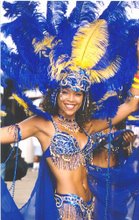BRAZILIAN CULTURAL CENTER OF HAWAII - Culture and Traditions
Brazilian culture is a clear reflection of its history and the origins of its people - from Portugal, Africa and South American. Brazilian festivals and most notably, its music, have deep roots in the heritage of its people.
Brazilian music is a very important part of Brazilian life and the country's annual celebrations. Within Brazilian songs, you can hear the influence of Spanish melodies and African rhythms. Among some of the most popular Brazilian musical styles is the Samba, a very lively, rhythmic and dance-oriented musical style. Some of the world's greatest musicians are Brazilians.
Both the music and the dance of samba are taught throughout Brazil at many different "samba schools". Children and adults study year-round the samba dance, then show off their dancing skills at Brazil's many festivals and at dance halls and auditoriums throughout the country. Most of the schools compete in samba dancing competition at the Sambadromo, an 85,000-seat auditorium in Rio de Janeiro. The Sambadromo competition follows a parade of samba schools during Carnival, by far the largest and most popular of Brazil's annual festivals.
Celebrated in the four days before the Roman Catholic Lent, Carnival in Brazil is a combination of a religious holiday and African-style celebrations. Millions of Brazilians spend a lot of time each year in preparation for Carnival. In addition to samba schools, Brazilians prepare for Carnival by building parade floats and creating elaborate and beautiful costumes. In addition to the parades and dancing competitions, many Brazilians celebrate Carnival in nightclubs. In Rio de Janeiro, where Carnival partying is the most pronounced, streets and buildings are decorated with colorful streamers and lights.
There are other holidays and festivals in Brazil throughout the year. Among them are St. John's Night in June that is celebrated with fireworks. On New Year's Day, fishermen along the coast celebrate Iemanjá, the African goddess of the ocean. Brazilian fishermen believe this celebration can affect the following year's catch.
The Brazilian people come from a mixture of races. Portuguese explorers, natives and African slaves (most of them coming from Yoruba and Quimbundu that correspond to Nigeria, Benin and Angola nowadays) constituted the racial base. French and Dutch explorers also had been on the northeast of Brazil. On the XX century, a lot of German, Italian, Polish and Japanese immigrants added new elements to this mixture. Maybe Brazil is the main country with miscegenation. Formation of population
The following races participate on the formation of population: white, coming from Europe; black, coming from Africa and Mongolian people, the Indian born on Brazil. The miscegenation is intense from the beginning of the colonization. The small number of white women among the Portuguese explorers makes them to be an acquaintance of Indian and black slaves, many times by brute force. This miscegenation originates other racial groups, like mulattos, originated from the miscegenation of white and black; cooper-colored or mameluco, originated from the miscegenation of white and Mongolian; cafuzo, originated from the miscegenation of black and Mongolian. People that arrived late on Brazil, although in many cases they have stayed in restricted communities, also miscegenated with other races. Immigrants
The number of immigrants on Brazil always was greater than the number of emigrants. The immigration officially started when Dom João VI promulgated the law that permits the possession of lands to foreigners, in 1808, November. The purpose of this law is to facilitate the occupation on the South of Brazil, ensuring an attractive country to Castilians. They also are interested in "becoming people white"; on that time the majority were black. The presence of immigrants causes changes on the country’s life. They introduced new growing products and techniques, the notion of small property, the subsistence economy and the small domestic industries (textile, food, leather and ceramics). Main currents – The people who immigrated to Brazil are German, Austrian, Hungarian, Slavic, Spanish, Italian, Japanese, Syrian, Lebanese, and German Swish.
Religion
There’s no official religion on the country. Almost 88% of the Brazilian inhabitants are catholic. However, approximately twenty million Catholics also participate in some kind of ritual cult of African origin. There also are at least five million protestants, including an important number of Lutherans, Methodists, Episcopalian and Jewishs.
Most of the Indian profess traditional religions.
The Church and the State are formal and completely separated.
Brazil loves festivals. It is an integral part of the national character to commemorate, party, and reunite friends together for any reason. Or even if there is no particular reason, anything provides a pretext for diversion, entertainment, commemoration or joyful partying for its own sake. The birth of a child? It deserves a celebration. Meeting up with an old friend?
Likewise. A Friday feeling? A perfect excuse for a party. Feeling a bit low?
Why not let your hair down? These are but small ommemorations compared to when housands of people have the same intention resulting in a festive explosion. A samba school from Rio de Janeiro comprising of five thousand participants and a packed grand stand all dancing the samba together. A crowd going up and down the steep streets of the town of Olinda in Pernambuco after the music of the frevo for days on end. There are so many examples all over the country. There are religious festivals like the cleaning of the stairway leading to the Senhor de Bonfim church in Salvador, for the great procession of Círio de Nazaré in Belém do Pará.
There is no great difference between religious events or pagan festivals. It is through these popular manifestations that the people of Brazil let go and show their exuberance, these are moments that approach a palpable and tangible glory that exceeds the moment and lasts until at the least the next .
Subscribe to:
Post Comments (Atom)






















No comments:
Post a Comment